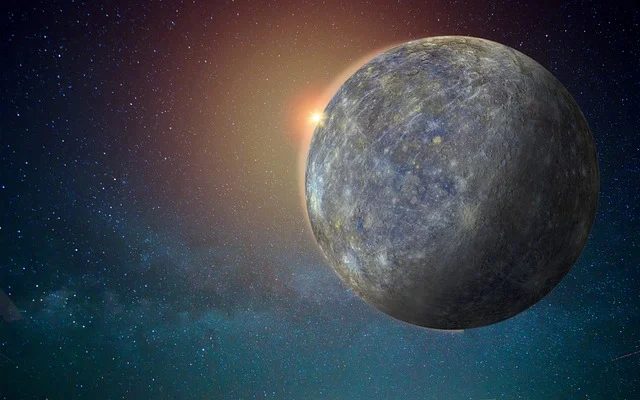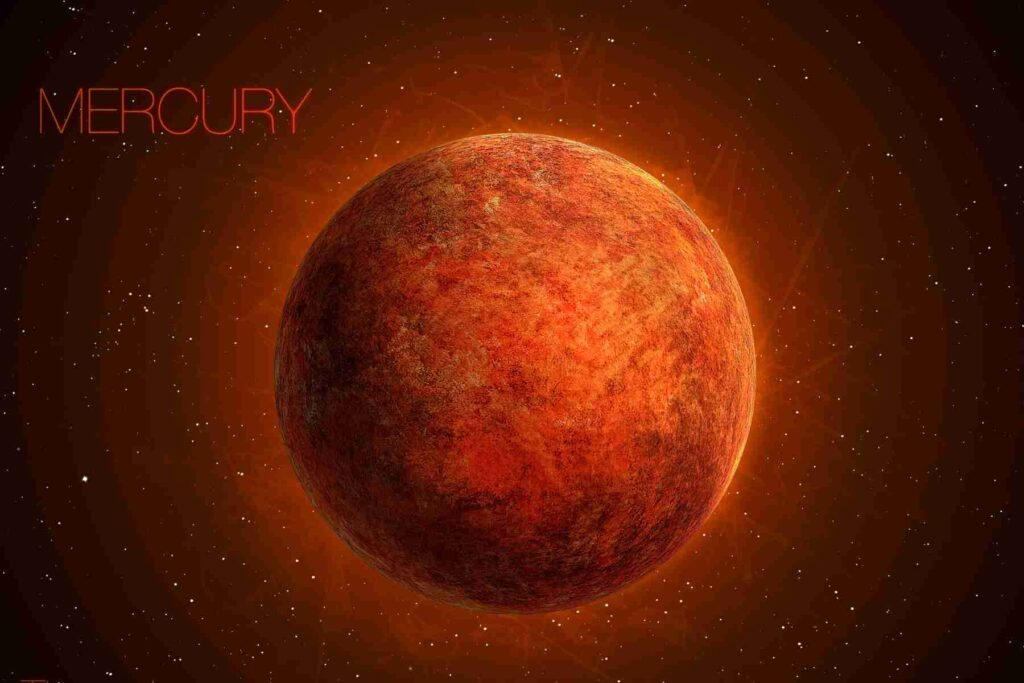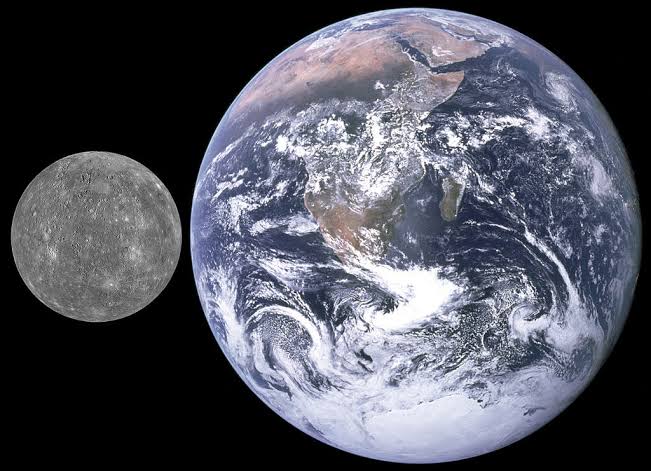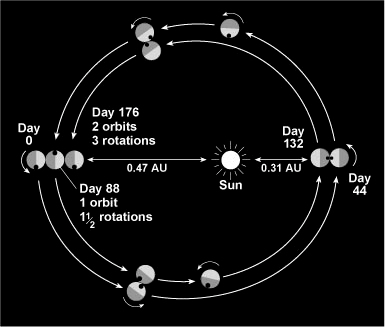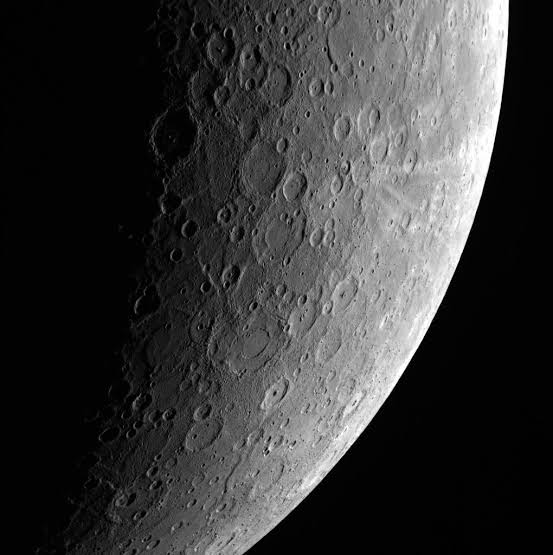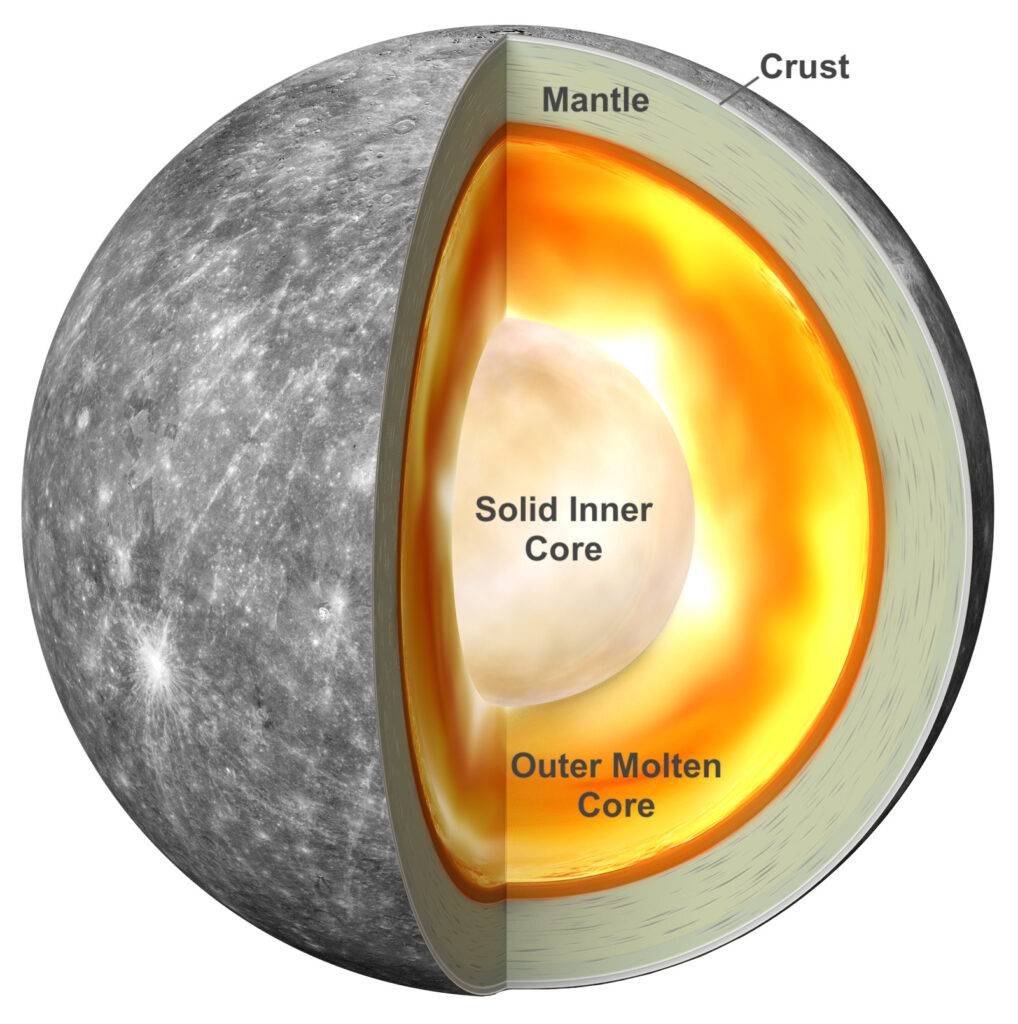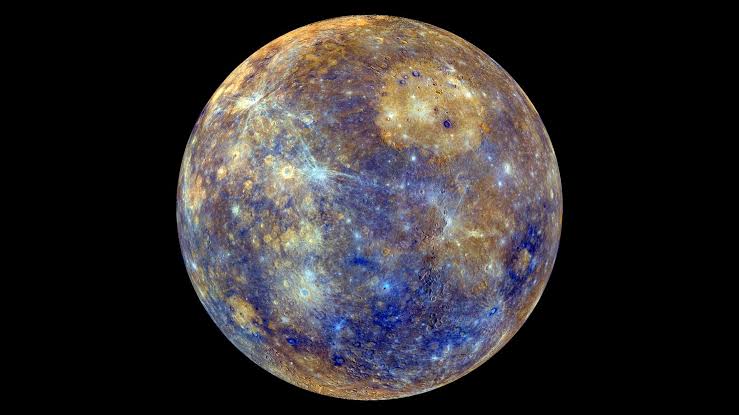Planet Mercury is our solar system’s tiniest planet. It’s about the same size as Earth’s Moon. Although it is the closest planet to the Sun, it is not the warmest. Venus has a higher temperature.
Various intriguing questions will be discussed in this post. What is Mercury’s exact size? What is Mercury’s distance from the Sun? And there would be answers to a slew of other questions about Mercury, thus justifying the title complete information about planet Mercury.
Planet Mercury facts
| Diameter: | 4,879 kilometres |
| mass: | 3.30 × 1023 kg |
| Moons: | none |
| Orbit Distance: | 57,909,227 km (0.39 AU) |
| surface area: | 74,797,000 km2 |
| Surface Temperature: | -173 to 427°C |
| Orbit Period: | 88 days |
| Density: | 5.43 g/cm³ |
| Radius: | 2,439.7 km |
| gravity: | 3.7 m/s² |
| Average distance from Sun: | 57.91 million kilometres |
| Discovered by: | Assyrian astronomer around 14th century BC |
What is the size of Mercury?
Mercury is the smallest planet in our solar system with a diameter of around 4800 kilometres. This size is quite similar to the size of the United States. Mercury is just two-fifths the size of the Earth. It is even smaller than the moons of Jupiter and Saturn.
If you want to know more about the moon of Saturn, Titan and whether it can support life or not, you can hop onto our other article on Titan. One such thing about Mercury is that scientists believe that it is shrinking! Mariner 10, NASA’s mission to Mercury revealed unusual features called scarps.
These are formed when the hot interior of a planet cools, the surface comes together. Since the planet is a single layer of rock, it pushes onto itself to form scarps. Data suggest that in the last 4.5 billion years since its birth, the planet has contracted nearly 7 kilometres.
How far is Mercury from the Sun?
At a distance of 57.91 million kilometres / 35.98 million miles or 0.4 AU, Mercury is the nearest planet to the Sun and it takes just 3.2 minutes for sunlight to reach the surface of Mercury.
How did the formation of Mercury take place?
Mercury is thought to have been created approximately 4.5 billion years ago when gravity drew spinning gas and dust together to form a small planet. Its small size and massive core are thought to have resulted from a collision with another massive object, which stripped much of its surface.
Mercury Orbit and Rotation
Mercury takes the shortest time to revolve around the Sun which is pure because of its proximity to the S. It takes just 88 Earth days to complete one revolution around the Sun and travels at a speed of nearly 180,000 kilometres/hour. This speed is faster than any other planet in the solar system.
Mercury has a highly elliptical orbit. It has the highest eccentricity of its orbit among any other planet. During its revolution around the Sun, it can be as close as 47 million kilometres to the Sun while at some point, it can be 70 million kilometres from the Sun. Interestingly, if one could possibly stand on the surface of Mercury while it as its nearest to the Sun, the sun would appear three times larger as seen from the Earth.
Apart from this, it takes around 59 Earth days to complete one rotation around its axis. Combining this with the elliptical orbit, on the surface, the sun appears to rise briefly, set and rise again before travelling to the west. During sunset, the same happens and the Sun sets again.
How long is a day on Mercury?
Mercury takes just 88 days to complete one revolution but its slow rotation makes a day twice as long. Essentially, on the surface of Mercury, the period between sunrise, sunset and rising to the same position would be almost 176 Earth days.
What is the surface of Mercury like?
Most of the things or activities that happen on Mercury are prominently due to the high temperature. Day temperatures can be as high as 450 degrees Celsius. Because the planet doesn’t have a real atmosphere for trapping heat, the night temperatures drop to extremely low numbers such as -170 degrees Celsius.
Mercury’s surface is quite similar to our moon in terms of appearance and show features like craters, plains which indicates that it has been inactive for a long geological time. Mercury also has wrinkled ridges called dorsa, highlands like that of the moon, mountains, plains and valleys.
A study conducted in 2016 found out that surface features of Mercury can be classified into two groups:
- First, one comprising of older material that melts at higher pressures at the boundary of core and mantle.
- The second one is of newer materials that are formed closer to the surface.
Another study in the same year revealed that the dark colour of the planet is due to the presence of carbon. Researchers believe that this carbon was the remnant of the primordial crust of Mercury.
As the planet doesn’t have any atmosphere, asteroid attacks are quite prominent making the surface market up with craters. It is believed that nearly 4 billion years ago, a 100-kilometre wide asteroid struck the surface of Mercury.
This was equal to an impact of about 1 trillion 1-megaton bombs which created a huge crater on the surface around 1500 km wide. This crater is popularly called the Caloris Basin. Another asteroid impact could be held responsible for the odd spin of the planet.
Structure of Mercury
Mercury has three primary layers: a core, mantle, and crust. Mercury’s crust is devoid of tectonic plates, and its iron core is massive, accounting for 85 percent of the planet’s radius, compared to around 55 percent for Earth’s inner and outer cores.
Mercury’s total size is influenced by the core’s peculiar size, which causes it to decrease. For the past 4.5 billion years, the iron core has gently cooled and contracted. By doing so, it has dragged the planet’s surface inward, shrinking the planet’s size by 1–7 km (4 miles).
The planet’s composition is roughly 70% metallic and 30% silicate, resulting in a high density that places it as the second densest planet. If the effects of gravitational compression were to be taken into account for both Mercury and Earth, it is thought that Mercury would come out on top as the densest.
This density also indicates that the core is massive and iron-rich. The thickness of Mercury’s crust is thought to be roughly 35 kilometres or 22 miles.
Atmosphere – Exosphere
Just like the other planets have atmospheres, Mercury due to its closeness to Sun doesn’t hold a real atmosphere. Rather it has a thin exosphere that is made up of atoms that are blasted from the surface through solar radiations, winds and impacts.
According to researches conducted by NASA, it is a surface-bound exosphere containing 42% oxygen, 29% sodium, 22% hydrogen, 6% helium, 0.5% potassium. It also has some small amounts of other elements like argon, carbon dioxide, water, nitrogen, xenon and neon.
Magnetosphere
For planets to have a magnetic field around them, it is necessary to have a quick spin and a molten core. But Mercury poses a contradiction to this belief. Mariner 10 discovered that Mercury has a magnetic field. It is unexpected because it takes 59 days to rotate and its size is so small that the core would have cooled a long way back.
Further observations revealed that the field in the Northern hemisphere was thrice as that of the Southern Hemisphere. Scientists believe that the iron core of the planet might be cooling off from liquid to solid at the outer boundary of the core rather than the inner.
Mercury’s magnetic field is just 1% of Earth’s magnetic field but it is an active field. Combining it with the solar winds, they create powerful magnetic tornadoes which bring the hot plasma of solar winds to the surface.
Life Habitability – Can it have life?
As said earlier, temperatures play a huge role on Mercury. They vary a lot depending upon the day and night time. These extreme temperatures make the survival of life on the planet almost impossible. Even if you reach the surface, you would either be burnt up or freeze in a matter of a few seconds or minutes.
Missions to Mercury
- The first spacecraft to study Mercury was the Mariner 10 which detected the magnetic field of the planet.
- In 2011, the Messenger orbiter became the second after Mariner 10. It became the first spacecraft to orbit the planet. Sadly, it ran out of fuel and crashed on the surface on April 30, 2015.
- In 2016, the first-ever global digital elevation model of Mercury was released. It combined the images by Messenger and revealed some crucial characteristics of its surface such as its highest and lowest points.
- The combined efforts of the European Space Agency and Japanese Aerospace Exploration Agency saw the launch of an explorer, BepiColombo. It consisted of two spacecraft which will split up to study more about the planet. Both the agencies will play their separate roles in the mission with ESA studying the surface while the JAEA will focus on the magnetosphere. The proper research mission will start from 2025 while lasting for 1 Earth year or 4 Mercury years.
Conclusion
Mercury is the nearest planet to Sun and was formed along with the other planets around 4.5 billion years ago. It is the fastest planet to complete a revolution around the Sun taking just 88 days but the slow rotation makes the Mercurian days a lot longer in length. It has a surface much like that of our moon with craters and plains on it.
Much of the activities on the planet depend on the high temperatures which can be extremely cold or extremely hot. These temperatures don’t allow any kind of life to prosper on the planet. Recent missions have revealed a lot about the planet such as its surface, its rotation and the magnetosphere and BepiColombo is still in continuation and is hopeful to know more details about it.
We would like to thank you for sticking with this article (Complete information about planet Mercury) If you liked our article, please drop down your feedback in the comments section.
FAQ related to Planet Mercury
Q- Does Mercury has water on its surface?
Ans: The high temperatures don’t allow the presence of water on the surface. Thus, Mercury has no water available on it.
Q- Which planet in the solar system has the most craters?
Ans: In our solar system, Mercury has the highest number of craters on its surface.
Q- How big is the biggest crater on Mercury?
Ans: The biggest crater on Mercury is capable of fitting entire Western Europe inside it.
Q- What makes Mercury a famous planet?
Ans: The closeness and the fast motion of Mercury around the sun makes it a famous planet. Without a doubt, it gets its name from the fastest Roman god, Mercury.
Q- How is the interior of Mercury like?
Ans: According to scientists, it is much similar to Earth’s interior consisting of a large core of liquid metal and a silica mantle and solid crust on the outside. The core accounts for 42% of Mercury’s interior.
